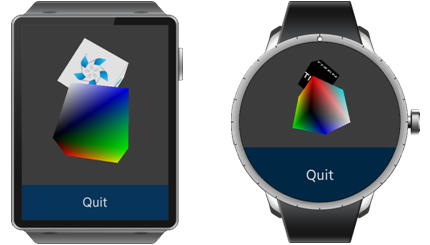GLView
This feature is supported in wearable applications only.
The GLView component renders OpenGL in an elementary object, which hides Evas GL complexity. For more information, see OpenGL ES and the OpenGL API.
Figure: GLView example

Figure: GLView hierarchy

Adding a GLView Component
Create a GLView component with the elm_glview_add() function:
Evas_Object *glview, *parent; glview = elm_glview_add(parent);
Set the size of the GLView to 200x200 pixels:
elm_glview_size_set(glview, 200, 200);
Using the GLView API
To use the GLView:
-
Configure the GLView rendering mode by activating the following rendering modes:
- ELM_GLVIEW_ALPHA: Alpha channel rendering mode
- ELM_GLVIEW_DEPTH: Depth buffer rendering mode
- ELM_GLVIEW_STENCIL: Stencil buffer rendering mode
- ELM_GLVIEW_DIRECT: Direct rendering mode
- ELM_GLVIEW_CLIENT_SIDE_ROTATION: The client handles the GL view rotation if direct rendering is enabled
In the following example, the alpha channel and depth buffer rendering mode are enabled.
elm_glview_mode_set(glview, ELM_GLVIEW_ALPHA | ELM_GLVIEW_DEPTH);
-
Set the resize policy. The following example shows how to decide what to do with the GL surface when the GLView component is resized.
elm_glview_resize_policy_set(glview, ELM_GLVIEW_RESIZE_POLICY_RECREATE);
The GL surface is destroyed and recreated to the new size (default function). The resize policy can also be set to ELM_GLVIEW_RESIZE_POLICY_SCALE. In that case, only the image object is scaled, not the underlying GL surface.
-
Set the GLView rendering policy:
elm_glview_render_policy_set(glview, ELM_GLVIEW_RENDER_POLICY_ALWAYS);
The GLView object is always redrawn during the rendering loop. It can also be set to ELM_GLVIEW_RENDER_POLICY_ON_DEMAND (default function), where the GLView component is redrawn only when it is visible.
-
Register the callbacks:
elm_glview_init_func_set(glview, _init_gl_cb); elm_glview_del_func_set(glview, _del_gl_cb); elm_glview_resize_func_set(glview, _resize_gl_cb); elm_glview_render_func_set(glview, _draw_gl_cb);
- elm_glview_init_func_set() registers an init callback that is called at the GLView object creation.
- elm_glview_del_func_set() registers a del function that is called when the GLView object is deleted.
- elm_glview_resize_func_set() registers the resize function that is called during the rendering loop when the GLView object is resized.
- elm_glview_render_func_set() registers the render function that is called when the GLView object must be redrawn.
Using GLView Callbacks
The GLView component emits the following signals:
- focused: The GLView component is focused. The event_info parameter points at an object of the type Elm_Focus_Info.
- unfocused: The GLView object is unfocused.
To register a callback for the focused signal:
{
evas_object_smart_callback_add(glview, "focused", focused_cb, data);
}
// Callback function for the "focused" signal
// This callback is called when the GLView is focused
void
focused_cb(void *data, Evas_Object *obj, void *event_info)
{
Elm_Focus_Info *fi = event_info;
dlog_print(DLOG_INFO, LOG_TAG, "GLView is focused\n");
}
| Note |
|---|
| Except as noted, this content is licensed under LGPLv2.1+. |

